Research on Energy Management Strategy for Hybrid Tractors Based on DP-MPC
Abstract
:1. Introduction
2. Tractor Power System and Main Parameters
3. Hybrid Tractor Model Construction
3.1. Tractor Driver Model
3.2. Generator Set Model
3.3. Drive Motor Model
3.4. Transmission System Model
3.5. Power Battery Model
3.6. Tractor Plowing Condition Dynamics Model
3.7. Tractor Rotary Tillage Condition Dynamics Model
3.8. Tractor Transportation Condition Dynamics Model
3.9. Tractor Simulation Model
4. Energy Management Strategy Design
4.1. Energy Management Strategy Based on Power Following
4.2. Energy Management Strategy Based on Dynamic Programming
4.2.1. Dynamic Programming Algorithm Model Building
4.2.2. The Solution Process of Dynamic Programming Algorithm
4.3. Energy Management Strategy Based on Model Predictive Control Solved by Dynamic Programming
4.3.1. Model Predictive Control-Based Energy Management Strategy Model
4.3.2. The Solution Process of Model Predictive Control
5. Analysis and Discussion of Hardware-in-the-Loop Test Results
5.1. Hardware-in-the-Loop Test Platform Setup
5.2. Result Analysis
5.2.1. Plowing Condition
5.2.2. Rotary Tillage Condition
5.2.3. Transportation Condition
5.3. Comparative Discussion
6. Conclusions
Author Contributions
Funding
Data Availability Statement
Conflicts of Interest
References
- Zhu, Z.; Lai, L.; Wang, D.; Chen, L.; Cai, Y. Energy Saving Characteristics of the Mechanical Hydraulic Tractor Power System with Oil Electric Hybrid Power. Nongye Gongcheng Xuebao Trans. Chin. Soc. Agric. Eng. 2022, 38, 52–60. [Google Scholar] [CrossRef]
- Zhu, Z.; Yang, Y.; Wang, D.; Cai, Y.; Lai, L. Energy Saving Performance of Agricultural Tractor Equipped with Mechanic-Electronic-Hydraulic Powertrain System. Agriculture 2022, 12, 436. [Google Scholar] [CrossRef]
- Gonzalez-de-Soto, M.; Emmi, L.; Benavides, C.; Garcia, I.; Gonzalez-de-Santos, P. Reducing Air Pollution with Hybrid-Powered Robotic Tractors for Precision Agriculture. Biosyst. Eng. 2016, 143, 79–94. [Google Scholar] [CrossRef]
- Beligoj, M.; Scolaro, E.; Alberti, L.; Renzi, M.; Mattetti, M. Feasibility Evaluation of Hybrid Electric Agricultural Tractors Based on Life Cycle Cost Analysis. IEEE Access 2022, 10, 28853–28867. [Google Scholar] [CrossRef]
- Scolaro, E.; Beligoj, M.; Estevez, M.P.; Alberti, L.; Renzi, M.; Mattetti, M. Electrification of Agricultural Machinery: A Review. IEEE Access 2021, 9, 164520–164541. [Google Scholar] [CrossRef]
- Moreda, G.P.; Muñoz-García, M.A.; Barreiro, P. High Voltage Electrification of Tractor and Agricultural Machinery—A Review. Energy Convers. Manag. 2016, 115, 117–131. [Google Scholar] [CrossRef]
- Mocera, F.; Somà, A. Analysis of a Parallel Hybrid Electric Tractor for Agricultural Applications. Energies 2020, 13, 3055. [Google Scholar] [CrossRef]
- Wang, Z.; Zhou, J.; Yang, H.; Wang, X. Design and Test of Measurement and Control System for Rapid Prototype Platform Used in Electric Tractors. Nongye Jixie Xuebao Trans. Chin. Soc. Agric. Mach. 2022, 53, 412–420. [Google Scholar] [CrossRef]
- Radrizzani, S.; Panzani, G.; Savaresi, S.M. Simultaneous Energy Management and Speed Control in a Hybrid Tractor with Experimental Validation. IEEE Trans. Control Syst. Technol. 2024, 32, 1285–1297. [Google Scholar] [CrossRef]
- Xie, B.; Wu, Z.; Mao, E. Development and Prospect of Key Technologies on Agricultural Tractor. Nongye Jixie XuebaoTransactions Chin. Soc. Agric. Mach. 2018, 49, 1–17. [Google Scholar] [CrossRef]
- Dou, H.; Wei, H.; Ai, Q.; Zhang, Y. Optimal Energy Management Strategy for Dual-Power Coupling Tractor Based on the Adaptive Control Technology. PLoS ONE 2023, 18, e0292510. [Google Scholar] [CrossRef] [PubMed]
- Mocera, F.; Martini, V.; Soma, A. Comparative Analysis of Hybrid Electric Architectures for Specialized Agricultural Tractors. Energies 2022, 15, 1944. [Google Scholar] [CrossRef]
- Medževeprytė, U.K.; Makaras, R.; Lukoševičius, V.; Kilikevičius, S. Application and Efficiency of a Series-Hybrid Drive for Agricultural Use Based on a Modified Version of the World Harmonized Transient Cycle. Energies 2023, 16, 5379. [Google Scholar] [CrossRef]
- Pascuzzi, S.; Lyp-Wronska, K.; Gdowska, K.; Paciolla, F. Sustainability Evaluation of Hybrid Agriculture-Tractor Powertrains. Sustainability 2024, 16, 1184. [Google Scholar] [CrossRef]
- Mocera, F.; Somà, A.; Martelli, S.; Martini, V. Trends and Future Perspective of Electrification in Agricultural Tractor-Implement Applications. Energies 2023, 16, 6601. [Google Scholar] [CrossRef]
- Medevepryt, U.K.; Makaras, R.; Lukoeviius, V.; Kerys, A. Evaluation of the Working Parameters of a Series-Hybrid Tractor under the Soil Work Conditions. Teh. Vjesn. 2022, 29, 45–50. [Google Scholar] [CrossRef]
- Wu, Z.; Wang, J.; Xing, Y.; Li, S.; Yi, J.; Zhao, C. Energy Management of Sowing Unit for Extended-Range Electric Tractor Based on Improved CD-CS Fuzzy Rules. Agriculture 2023, 13, 1303. [Google Scholar] [CrossRef]
- Yang, H.; Sun, Y.; Xia, C.; Zhang, H. Research on Energy Management Strategy of Fuel Cell Electric Tractor Based on Multi-Algorithm Fusion and Optimization. Energies 2022, 15, 6389. [Google Scholar] [CrossRef]
- Li, T.; Cui, W.; Cui, N. Soft Actor-Critic Algorithm-Based Energy Management Strategy for Plug-In Hybrid Electric Vehicle. World Electr. Veh. J. 2022, 13, 193. [Google Scholar] [CrossRef]
- Zhu, Y.; Li, X.; Liu, Q.; Li, S.; Xu, Y. Review Article: A Comprehensive Review of Energy Management Strategies for Hybrid Electric Vehicles. Mech. Sci. 2022, 13, 147–188. [Google Scholar] [CrossRef]
- Zou, K.; Luo, W.; Lu, Z. Real-Time Energy Management Strategy of Hydrogen Fuel Cell Hybrid Electric Vehicles Based on Power Following Strategy–Fuzzy Logic Control Strategy Hybrid Control. World Electr. Veh. J. 2023, 14, 315. [Google Scholar] [CrossRef]
- Wang, Q.; Li, D.; Miao, H. Research on Energy Management Strategy of Fuel Cell Vehicle Based on Fuzzy Logic Control. Qiche Gongcheng Automot. Eng. 2019, 41, 1347–1355. [Google Scholar] [CrossRef]
- Ghobadpour, A.; Mousazadeh, H.; Kelouwani, S.; Zioui, N.; Kandidayeni, M.; Boulon, L. An Intelligent Energy Management Strategy for an Off-Road Plug-in Hybrid Electric Tractor Based on Farm Operation Recognition. IET Electr. Syst. Transp. 2021, 11, 333–347. [Google Scholar] [CrossRef]
- Li, T.; Xie, B.; Wang, D.; Zhang, S.; Wu, L. Real-Time Adaptive Energy Management Strategy for Dual-Motor-Driven Electric Tractors. Nongye Jixie Xuebao Trans. Chin. Soc. Agric. Mach. 2020, 51, 530–543. [Google Scholar] [CrossRef]
- Yu, P.; Li, M.; Wang, Y.; Chen, Z. Fuel Cell Hybrid Electric Vehicles: A Review of Topologies and Energy Management Strategies. World Electr. Veh. J. 2022, 13, 172. [Google Scholar] [CrossRef]
- Zhang, H.; Fan, Q.; Wang, W.; Huang, J.; Wang, Z. Reinforcement Learning Based Energy Management Strategy for Hybrid Electric Vehicles Using Multi-Mode Combustion. Qiche Gongcheng Automot. Eng. 2021, 43, 683–691. [Google Scholar] [CrossRef]
- Chen, Z.; Fang, Z.; Yang, R.; Yu, Q.; Kang, M. Energy Management Strategy for Hybrid Electric Vehicle Based on the Deep Reinforcement Learning Method. Diangong Jishu Xuebao Trans. China Electrotech. Soc. 2022, 37, 6157–6168. [Google Scholar] [CrossRef]
- Qi, C.; Song, C.; Song, S.; Jin, L.; Wang, D.; Xiao, F. Research on Energy Management Strategy for Hybrid Electric Vehicles Based on Inverse Reinforcement Learning. Qiche Gongcheng Automot. Eng. 2023, 45, 1954–1964 and 1974. [Google Scholar] [CrossRef]
- Cao, Y.; Yao, M.; Sun, X. An Overview of Modelling and Energy Management Strategies for Hybrid Electric Vehicles. Appl. Sci. 2023, 13, 5947. [Google Scholar] [CrossRef]
- He, H.; Meng, X. A Review on Energy Management Technology of Hybrid Electric Vehicles. Beijing Ligong Daxue Xuebao Trans. Beijing Inst. Technol. 2022, 42, 773–783. [Google Scholar] [CrossRef]
- Du, C.; Huang, S.; Jiang, Y.; Wu, D.; Li, Y. Optimization of Energy Management Strategy for Fuel Cell Hybrid Electric Vehicles Based on Dynamic Programming. Energies 2022, 15, 4325. [Google Scholar] [CrossRef]
- Wang, Z.; Xu, S.; Luo, W. Research on Energy Management Strategy of Fuel Cell Vehicle Based on Dynamic Programming. Taiyangneng Xuebao Acta Energiae Solaris Sin. 2023, 44, 550–556. [Google Scholar] [CrossRef]
- Pan, C.; Liang, Y.; Chen, L.; Chen, L. Optimal Control for Hybrid Energy Storage Electric Vehicle to Achieve Energy Saving Using Dynamic Programming Approach. Energies 2019, 12, 588. [Google Scholar] [CrossRef]
- Yan, X.; Zhao, Y.; Liu, X.; Liu, M.; Wu, Y.; Zhang, J. Research on Energy Management Strategy for Series Hybrid Tractor under Typical Operating Conditions Based on Dynamic Programming. World Electr. Veh. J. 2024, 15, 156. [Google Scholar] [CrossRef]
- Jiang, D.-D.; Li, D.-F.; Yu, X.-L. Energy Management of HEV Based on Hybrid Model Predictive Control. Jilin Daxue Xuebao Gongxueban J. Jilin Univ. Eng. Technol. Ed. 2020, 50, 1217–1226. [Google Scholar] [CrossRef]
- Sun, L.; Lin, X.-Y.; Mo, L.-P. Multi-Objective Energy Management Strategy Based on Stochastic Model Predictive Control for a Plug-in Hybrid Electric Vehicle. Kongzhi Lilun Yu Yingyong Control Theory Appl. 2022, 39, 2274–2282. [Google Scholar] [CrossRef]
- Radrizzani, S.; Panzani, G.; Trezza, L.; Pizzocaro, S.; Savaresi, S.M. An Add-On Model Predictive Control Strategy for the Energy Management of Hybrid Electric Tractors. IEEE Trans. Veh. Technol. 2024, 73, 1918–1930. [Google Scholar] [CrossRef]
- Curiel-Olivares, G.; Johnson, S.; Escobar, G.; Schacht-Rodriguez, R. Model Predictive Control-Based Energy Management System for a Hybrid Electric Agricultural Tractor. IEEE Access 2023, 11, 118801–118811. [Google Scholar] [CrossRef]
- Jiang, D. Energy Management of Hybrid Electric Vehicles Based on Model Predictive Control. Ph.D. Thesis, Zhejiang University, Hangzhou, China, 2020. [Google Scholar]
- Wang, B.; Qiao, M.; Chu, X.; Shang, S.; Wang, D. Design and Experiment on Extended-Range Electric Caterpillar Tractor. Nongye Jixie Xuebao Trans. Chin. Soc. Agric. Mach. 2023, 54, 431–439. [Google Scholar] [CrossRef]
- Zhu, Z.; Zeng, L.; Lin, Y.; Chen, L.; Zou, R.; Cai, Y. Adaptive Energy Management Strategy for Hybrid Tractors Based on Condition Prediction. Hsi Chiao Tung Ta Hsueh J. Xian Jiaotong Univ. 2023, 57, 201–210. [Google Scholar] [CrossRef]
- Geng, W.; Lou, D.; Zhang, T. Multi-Objective Energy Management Strategy for Hybrid Electric Vehicle Based on Particle Swarm Optimization. Tongji Daxue Xuebao J. Tongji Univ. 2020, 48, 1030–1039. [Google Scholar] [CrossRef]
- Wang, Z.; Zhou, J.; Wang, X. Research on Energy Management Model for Extended-Range Electric Rotary-Tilling Tractor. Nongye Jixie Xuebao Trans. Chin. Soc. Agric. Mach. 2023, 54, 428–438. [Google Scholar] [CrossRef]
- Zhao, K.; He, K.; Li, J.; Liang, Z.; Bei, J.; Wang, Y. Multi-Objective Energy Management Strategy of HEV Based on Improved Dynamic Programming Method. Huanan Ligong Daxue Xuebao J. South China Univ. Technol. Nat. Sci. 2022, 50, 138–148. [Google Scholar] [CrossRef]
- Zhu, X. Research on Energy Management Strategy of Parallel Hybrid Electric Vehicle based on Dynamic Programming. Master’s Thesis, Hefei University of Technology, Hefei, China, 2017. [Google Scholar]
- Zhao, Z.; Shen, P.; Jia, Y.; Zhou, L. Model Predictive Real-Time Optimal Control of Fuel Cell Car. Tongji Daxue Xuebao J. Tongji Univ. 2018, 46, 648–657. [Google Scholar] [CrossRef]
- Jin, S. Research on Energy Management Strategy of Dual Motor Coupling Drive PHEV Based on Model Prediction. Master’s Thesis, Shandong University of Technology, Zibo, China, 2022. [Google Scholar]
- Sun, Y. Energy Management Strategy for a HEV Based on Model Predictive Control. Master’s Thesis, Dalian University of Technology, Dalian, China, 2018. [Google Scholar]
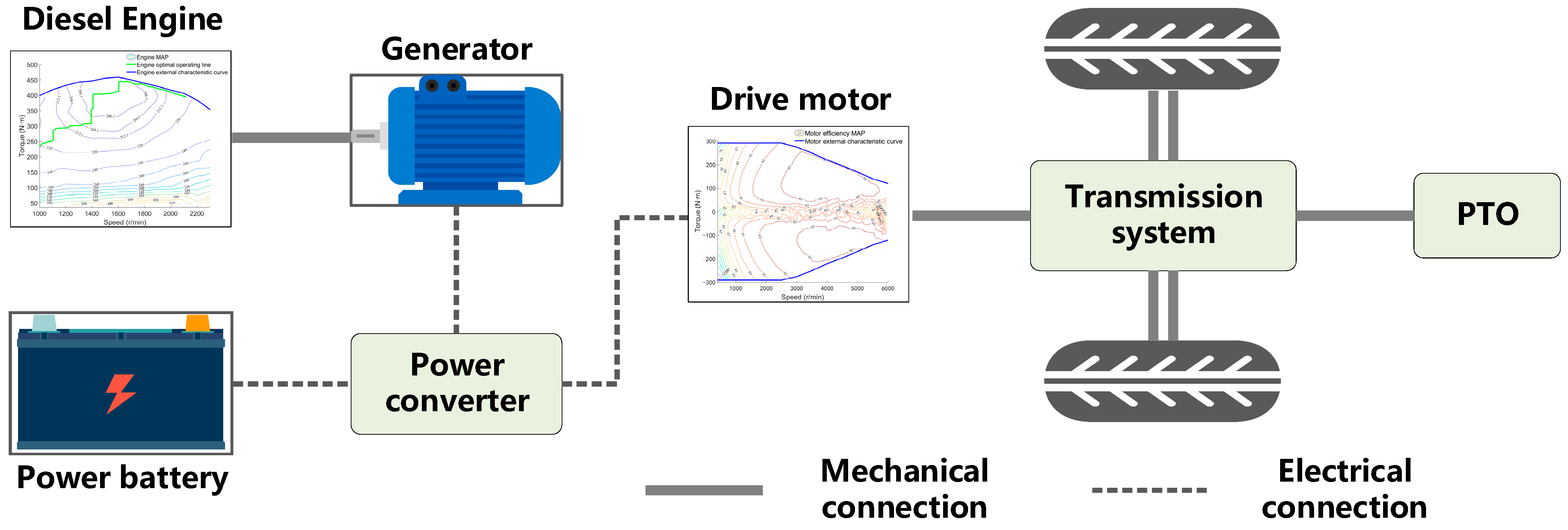



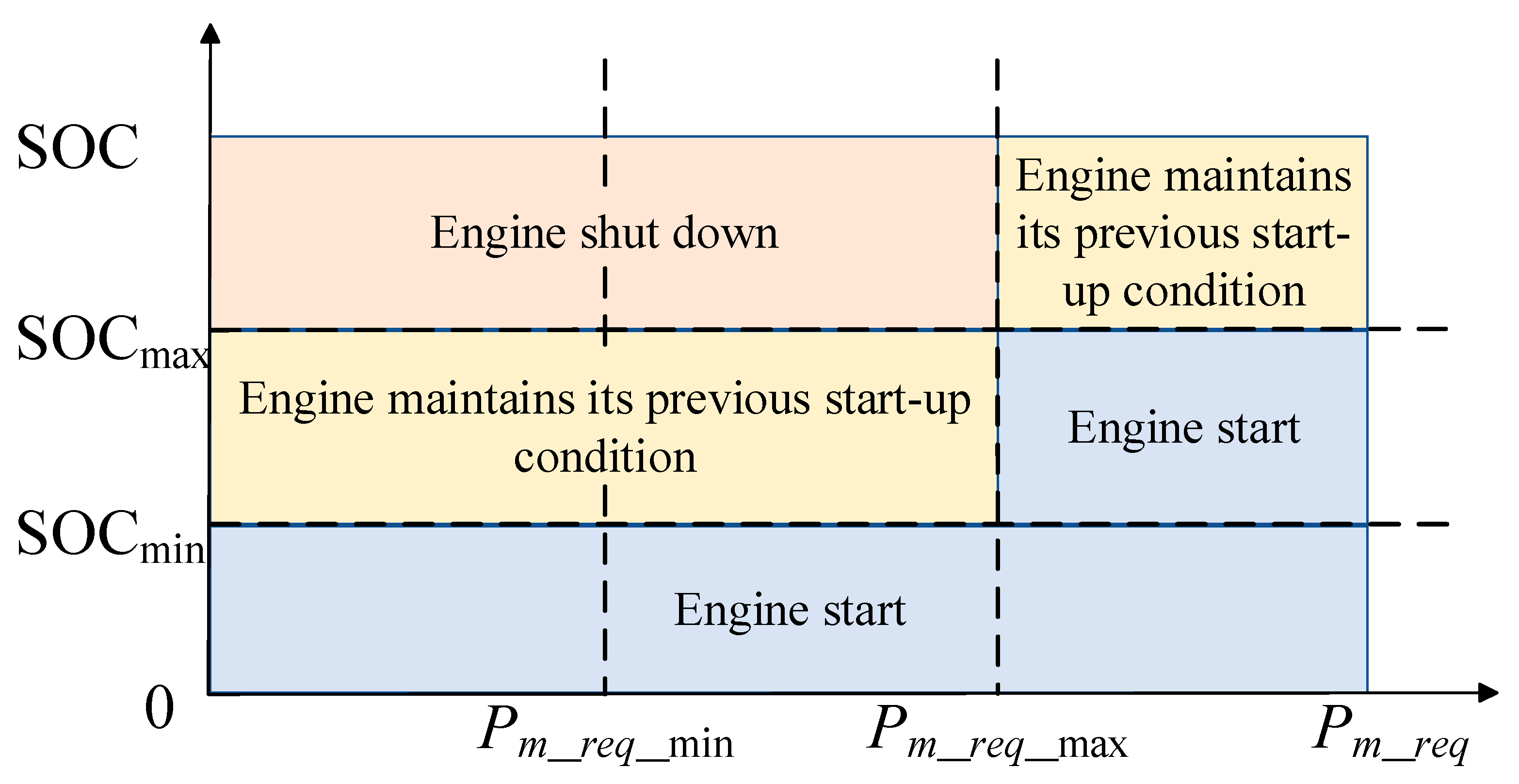
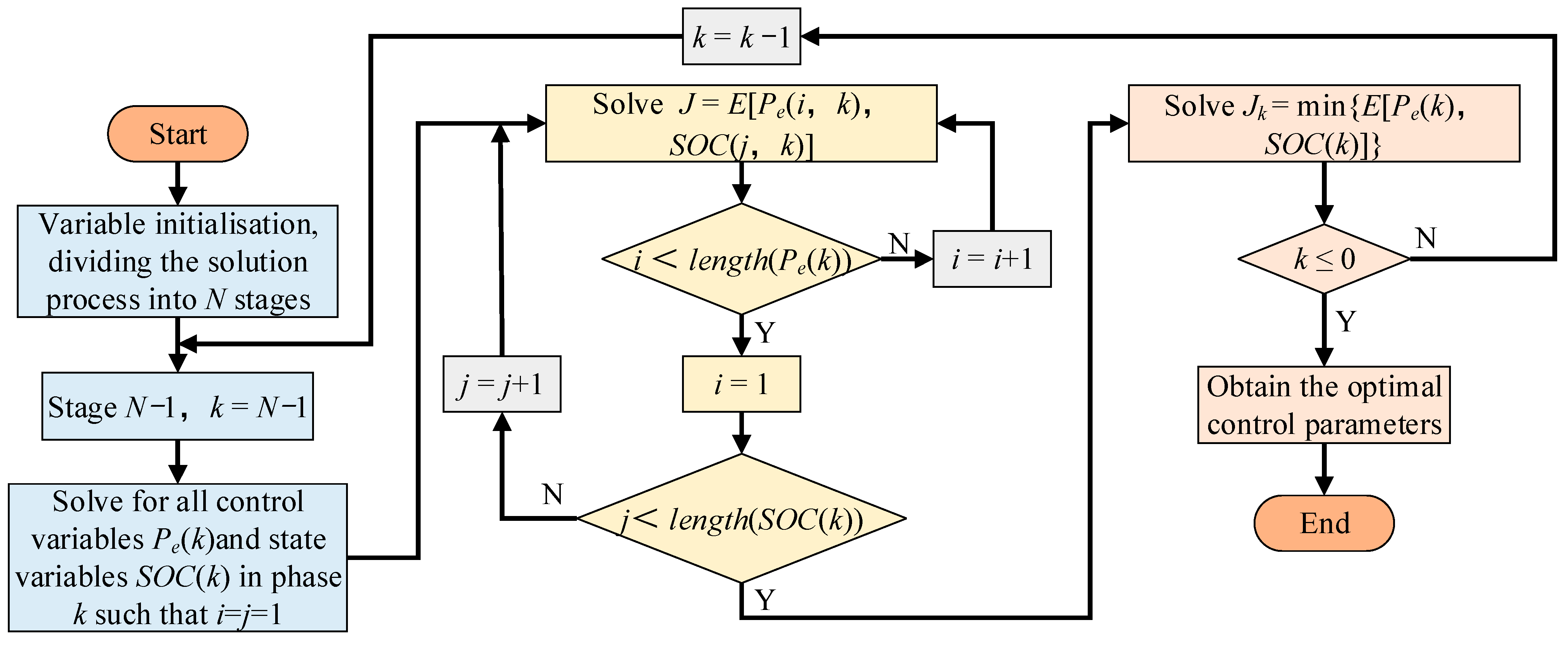

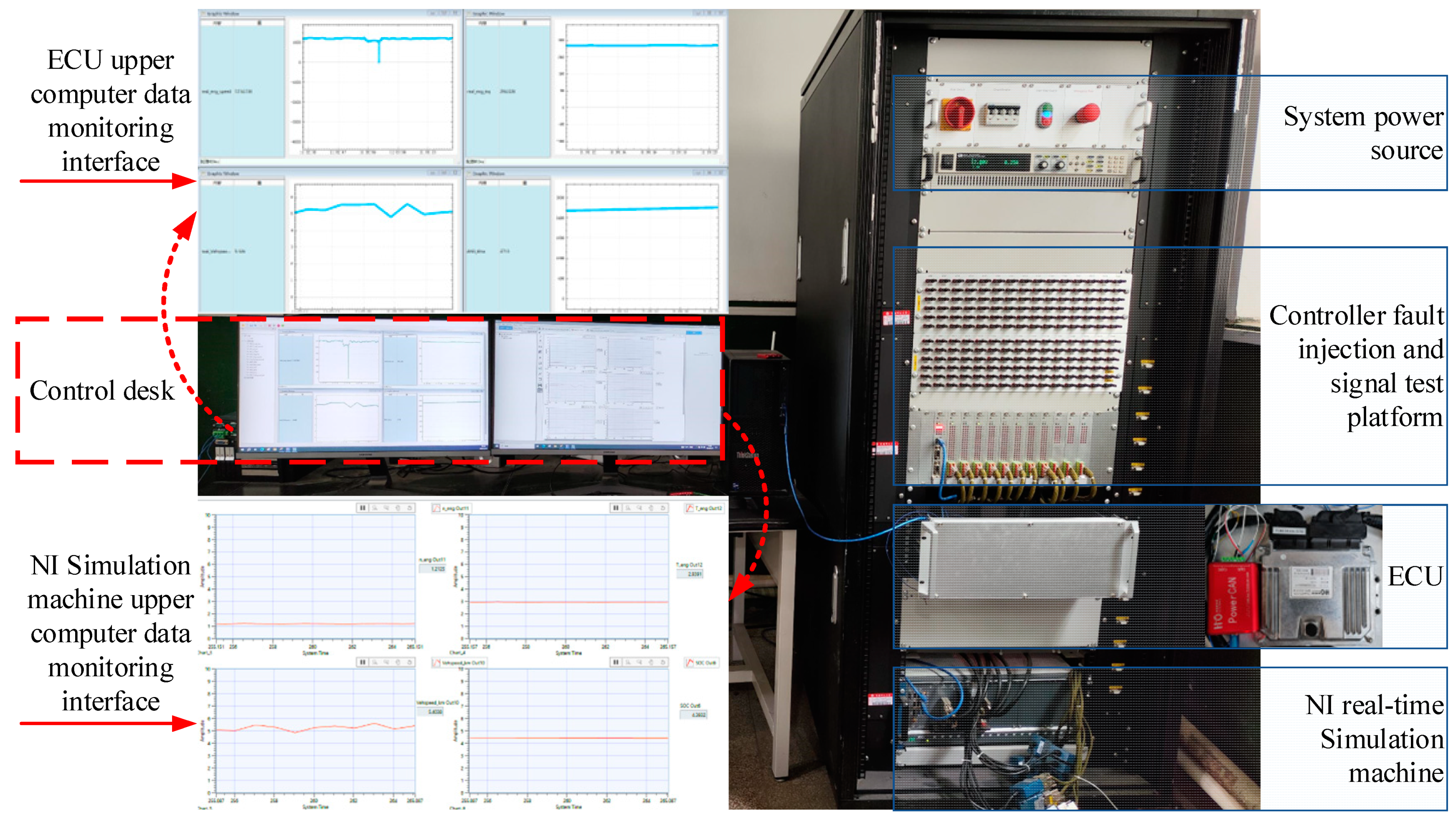
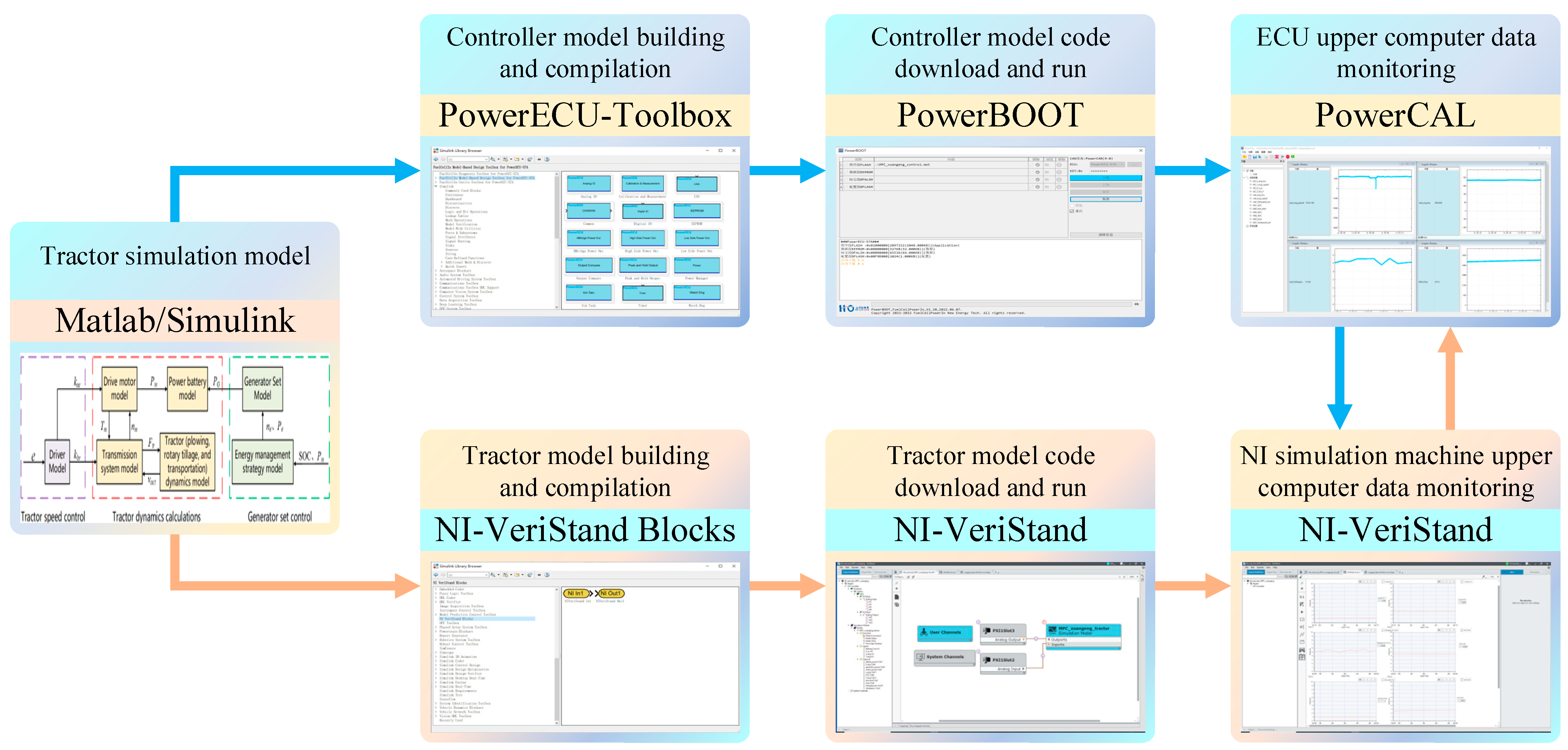
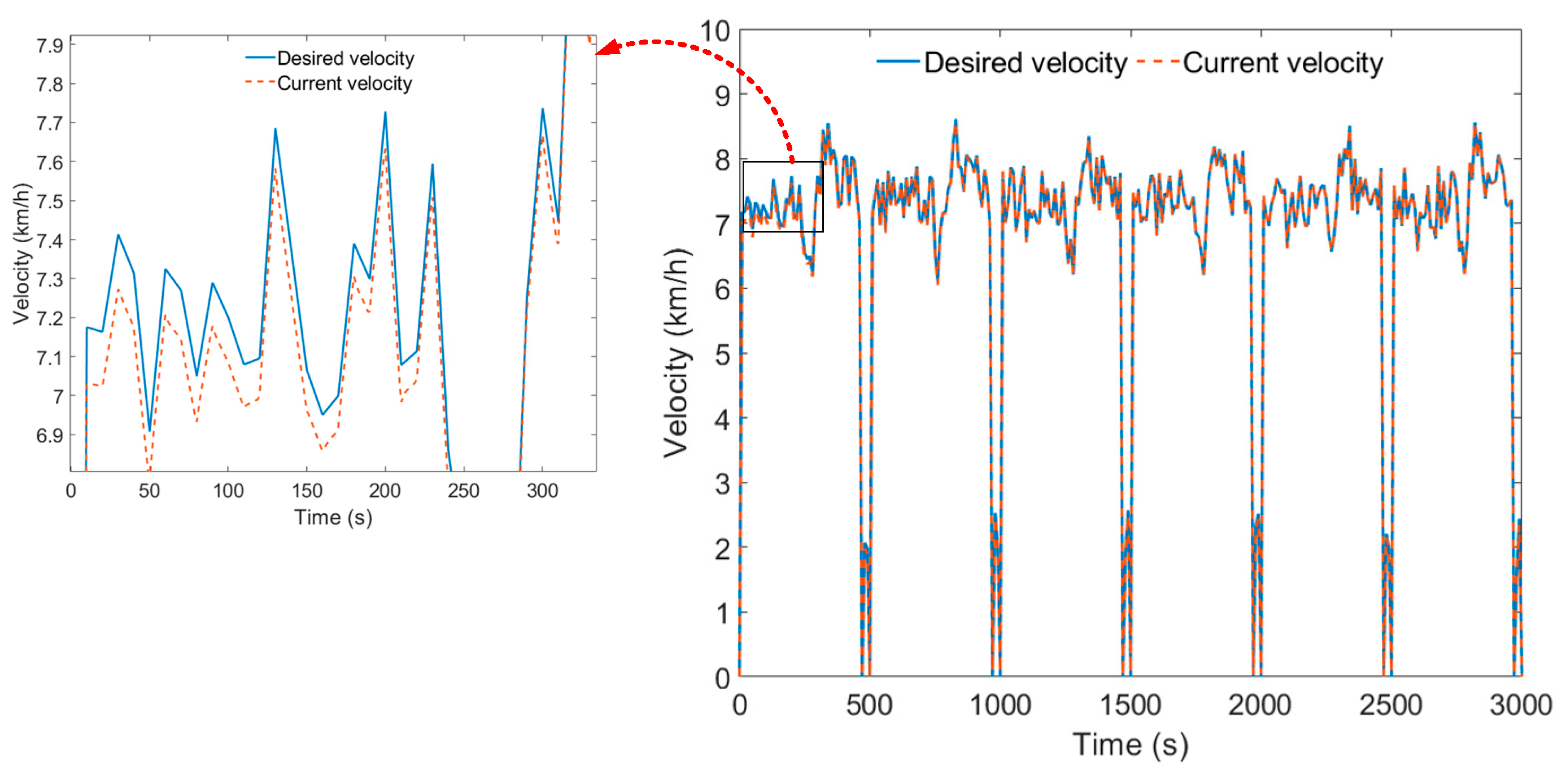
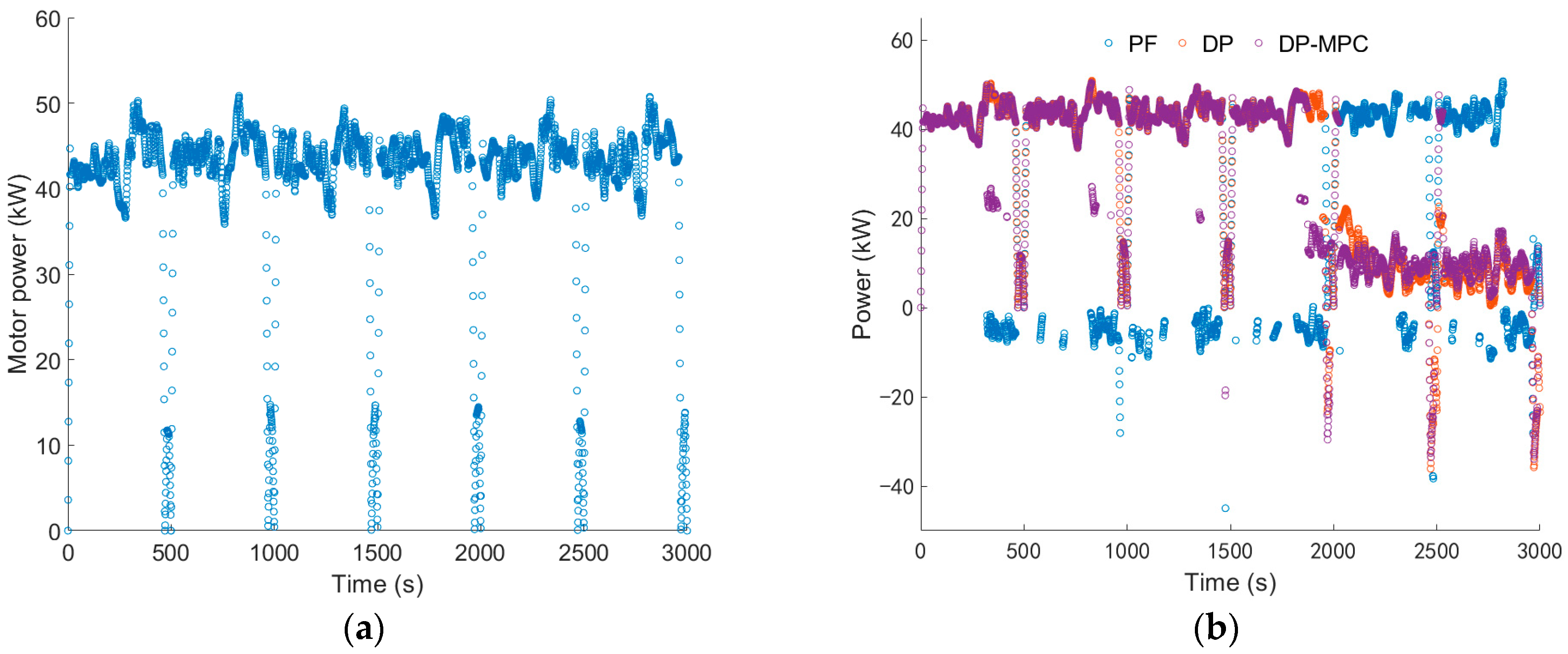

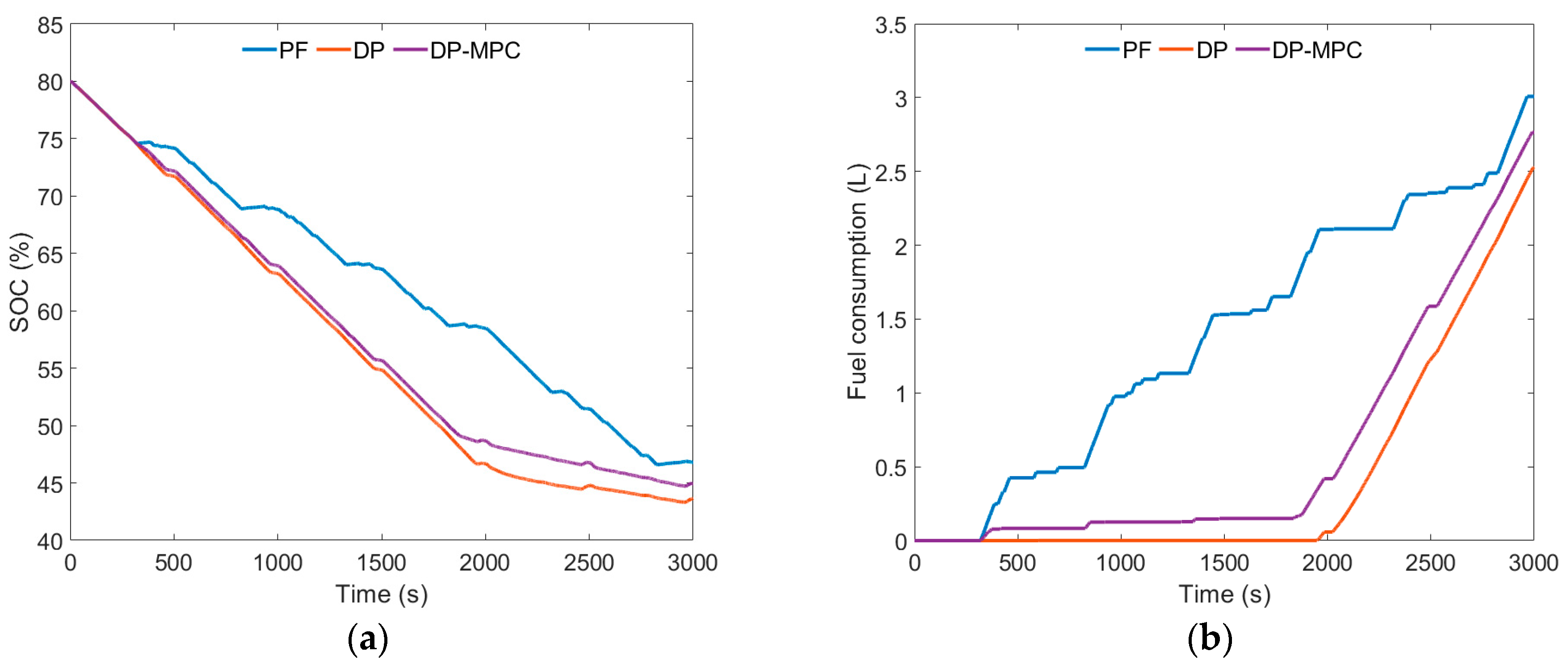
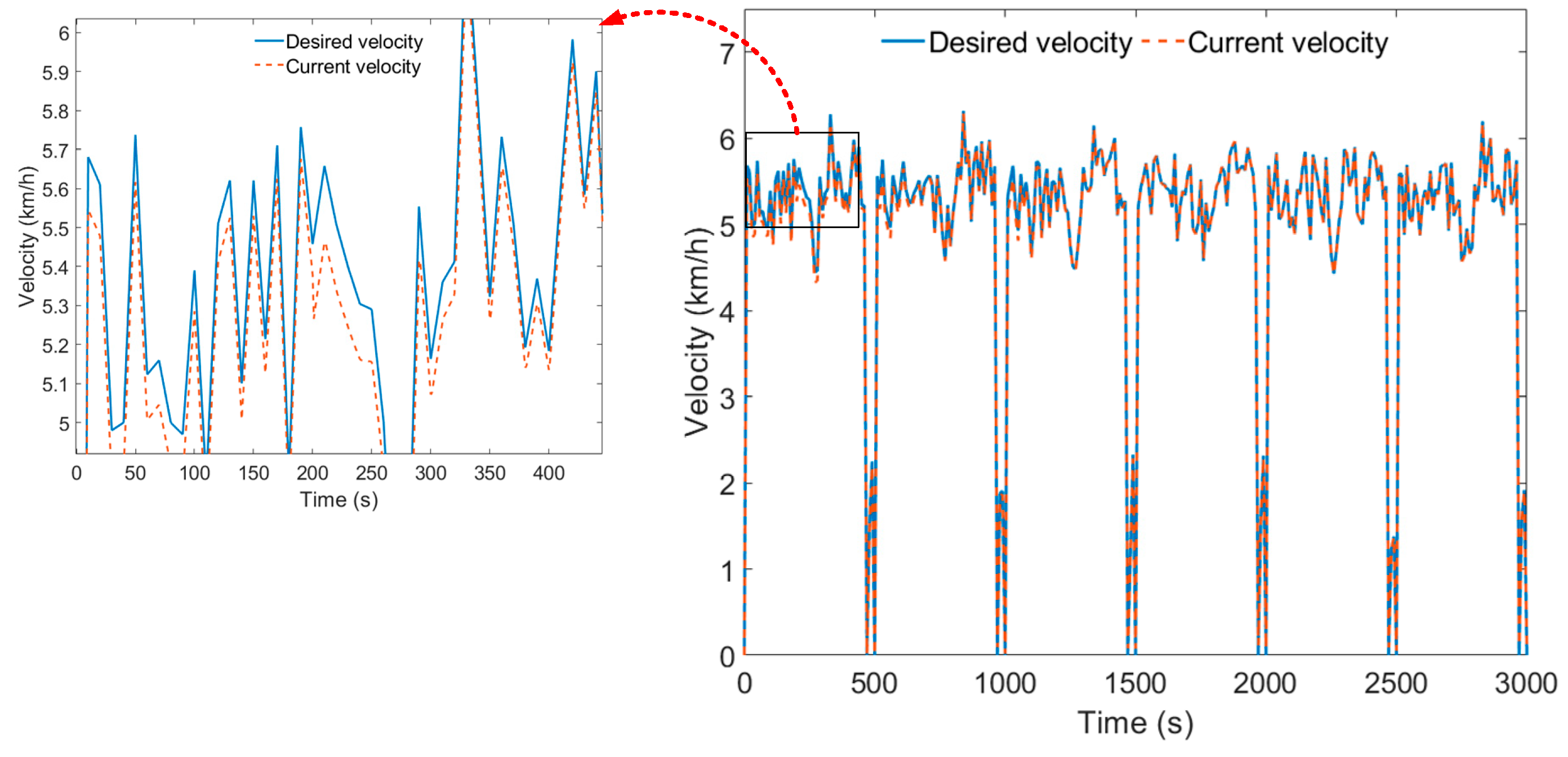
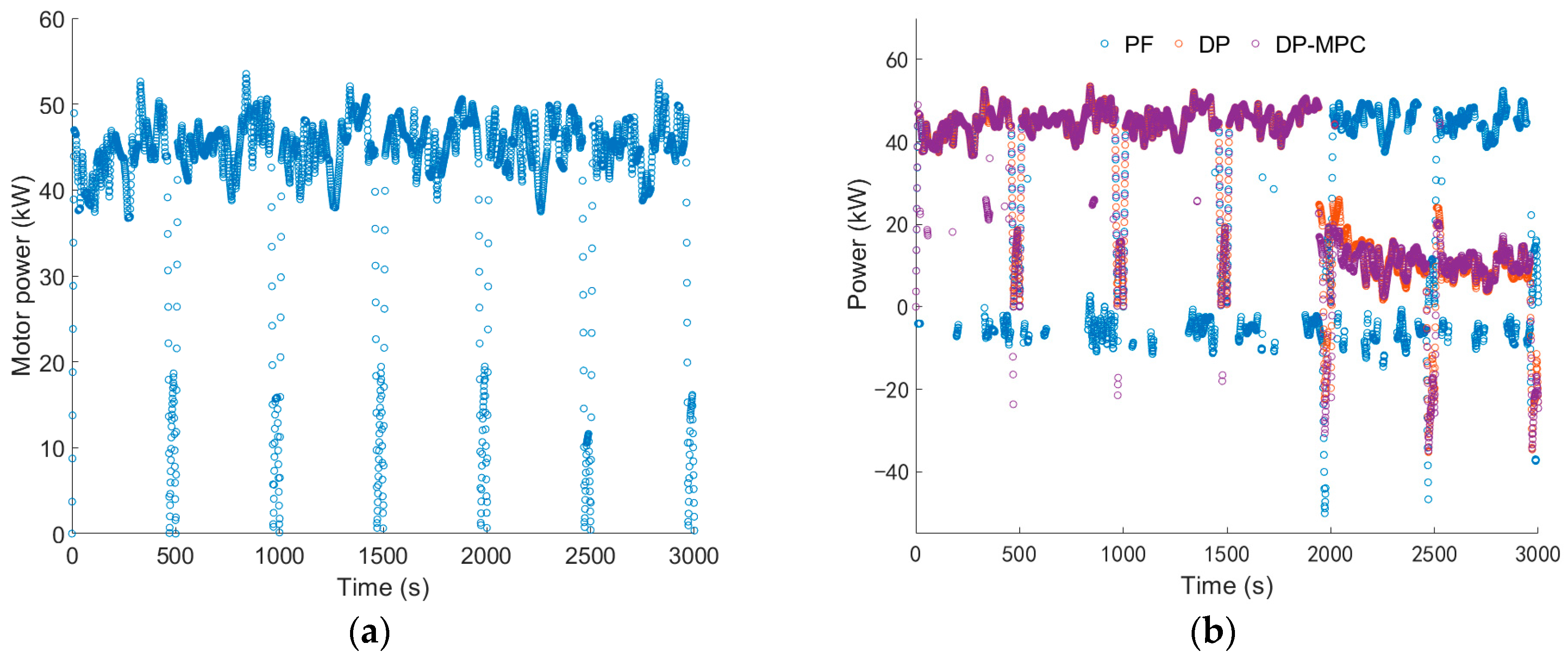
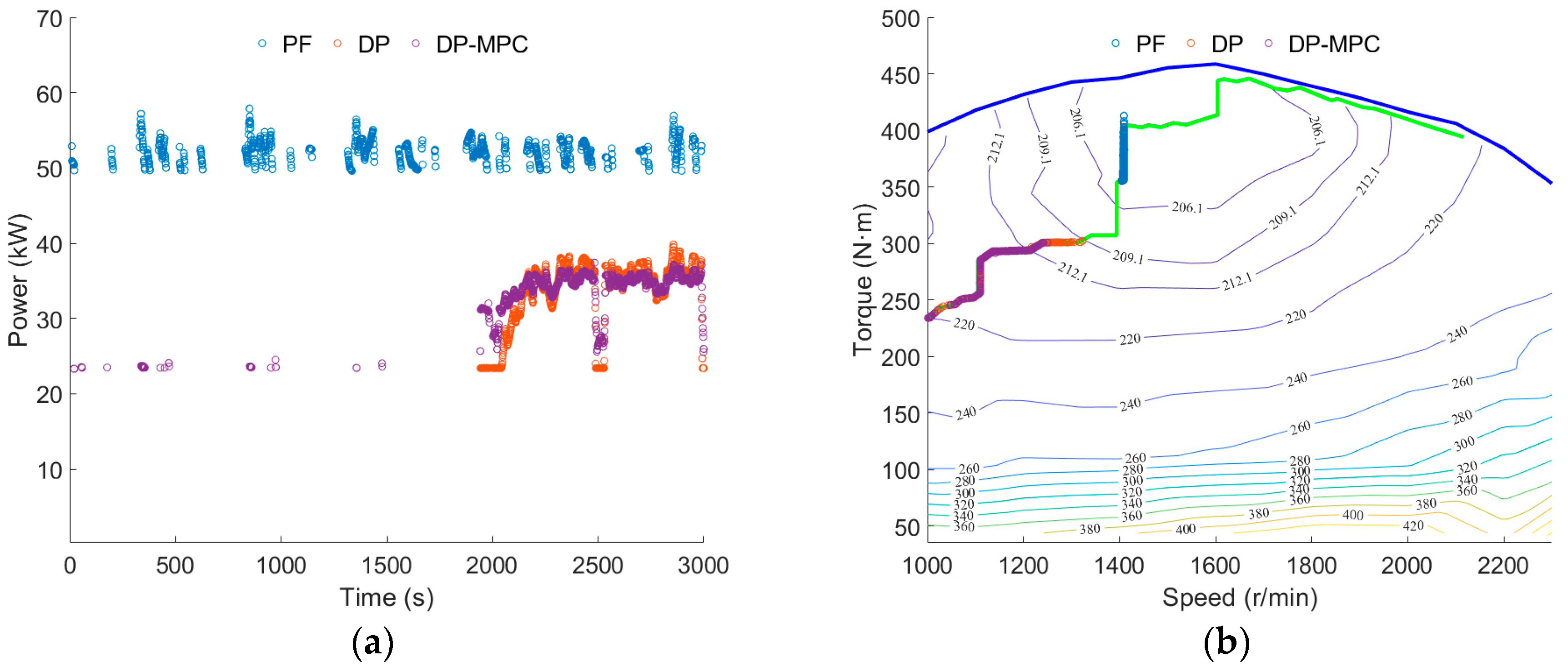
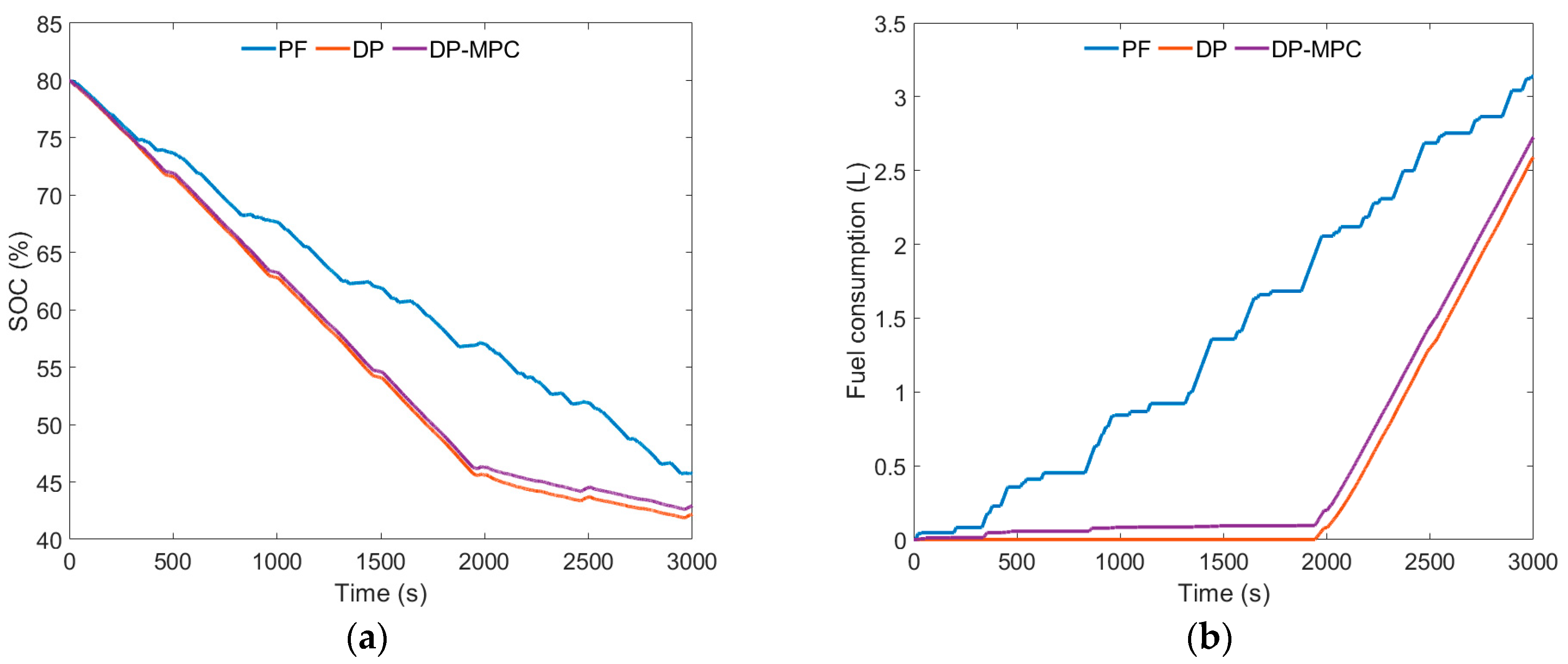
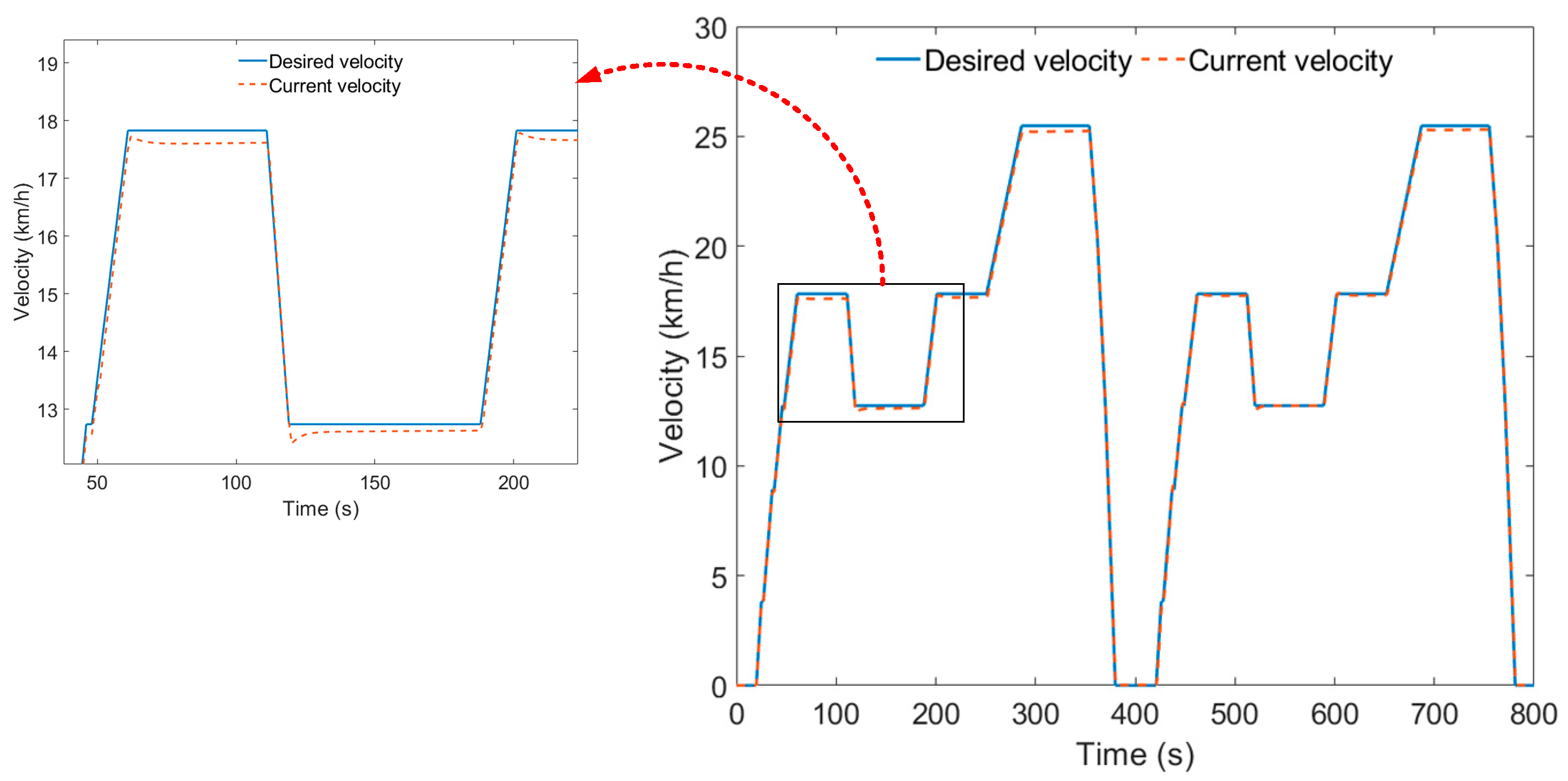
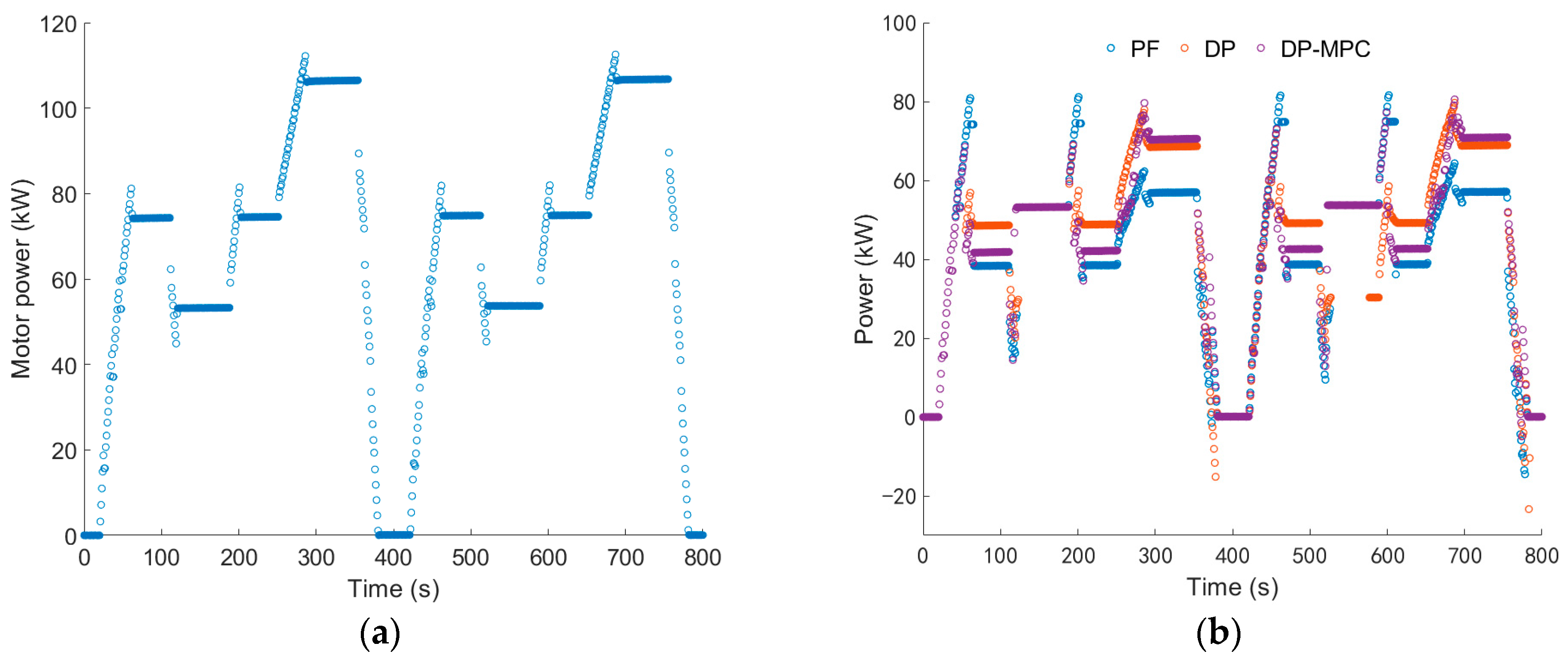
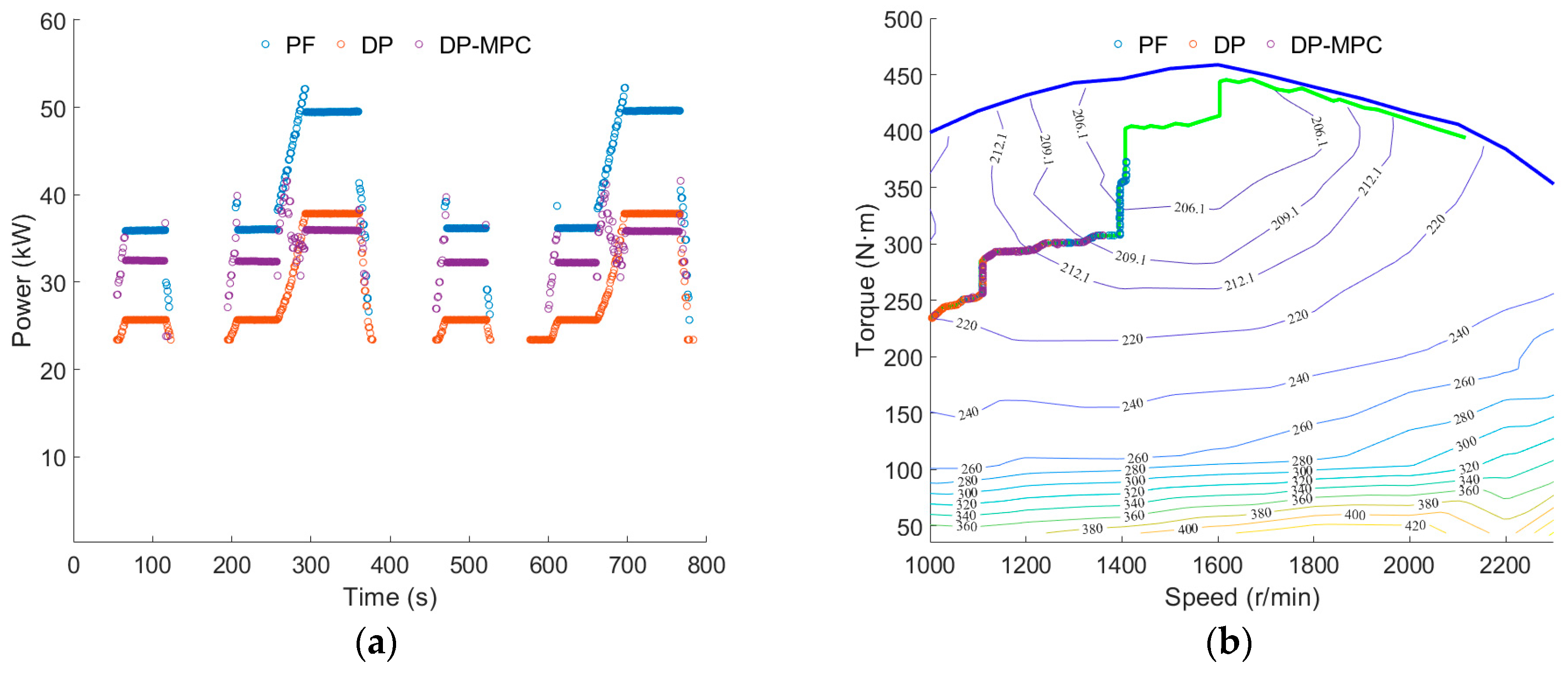


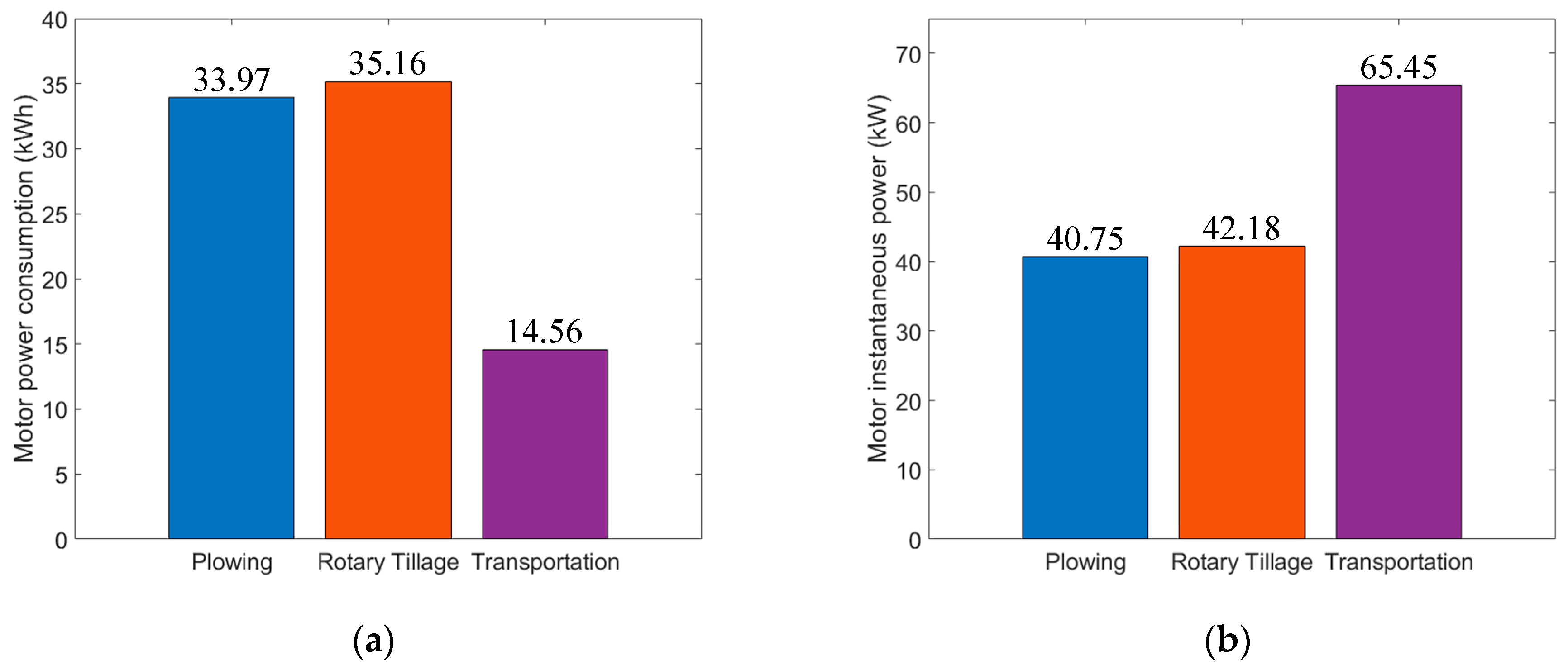
| Component | Parameter | Value (Unit) |
|---|---|---|
| Diesel engine | Rated power | 85 (kW) |
| Rated speed | 2300 (r/min) | |
| Maximum torque speed | 1500~1700 (r/min) | |
| Drive motor | Rated power | 63 (kW) |
| Peak power | 125 (kW) | |
| Rated speed | 2000 (r/min) | |
| Rated torque | 300 (N·m) | |
| Power battery | Rated capacity | 70 (A·h) |
| Rated voltage | 330 (V) | |
| SOC | 0.25~0.90 |
| Parameter | Value | Unit | Parameter | Value | Unit |
|---|---|---|---|---|---|
| Z | 3 | - | f | 0.12 | - |
| b | 25 | cm | B | 1.25 | m |
| h | 20 | cm | δ | 1.1 | - |
| k | 5 | N/cm2 | CD | 0.32 | - |
| m | 2145 | kg | A | 2.95 | m2 |
Disclaimer/Publisher’s Note: The statements, opinions and data contained in all publications are solely those of the individual author(s) and contributor(s) and not of MDPI and/or the editor(s). MDPI and/or the editor(s) disclaim responsibility for any injury to people or property resulting from any ideas, methods, instructions or products referred to in the content. |
© 2024 by the authors. Licensee MDPI, Basel, Switzerland. This article is an open access article distributed under the terms and conditions of the Creative Commons Attribution (CC BY) license (https://creativecommons.org/licenses/by/4.0/).
Share and Cite
Zhao, Y.; Xu, L.; Zhao, C.; Xu, H.; Yan, X. Research on Energy Management Strategy for Hybrid Tractors Based on DP-MPC. Energies 2024, 17, 3924. https://doi.org/10.3390/en17163924
Zhao Y, Xu L, Zhao C, Xu H, Yan X. Research on Energy Management Strategy for Hybrid Tractors Based on DP-MPC. Energies. 2024; 17(16):3924. https://doi.org/10.3390/en17163924
Chicago/Turabian StyleZhao, Yifan, Liyou Xu, Chenhui Zhao, Haigang Xu, and Xianghai Yan. 2024. "Research on Energy Management Strategy for Hybrid Tractors Based on DP-MPC" Energies 17, no. 16: 3924. https://doi.org/10.3390/en17163924





